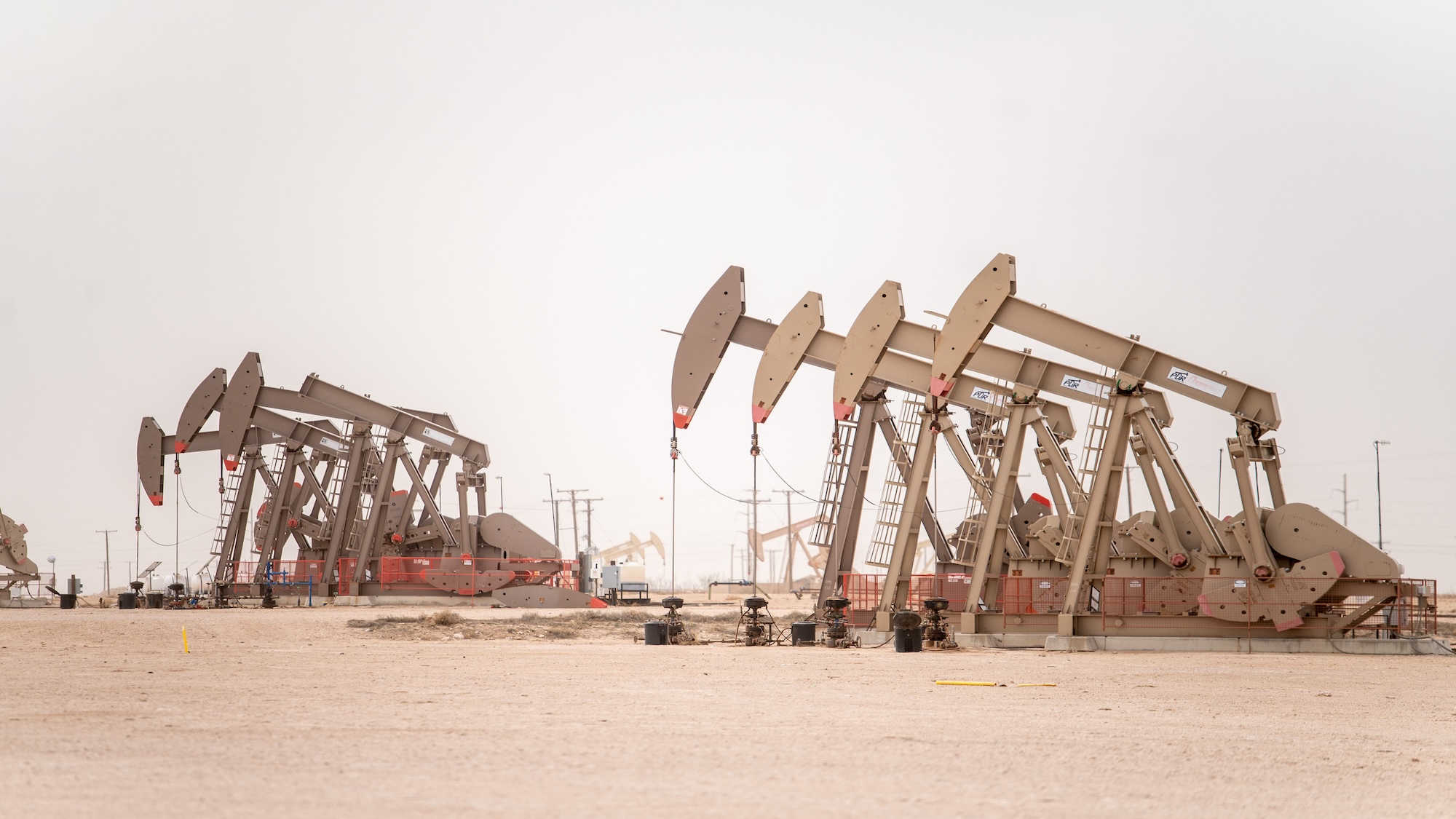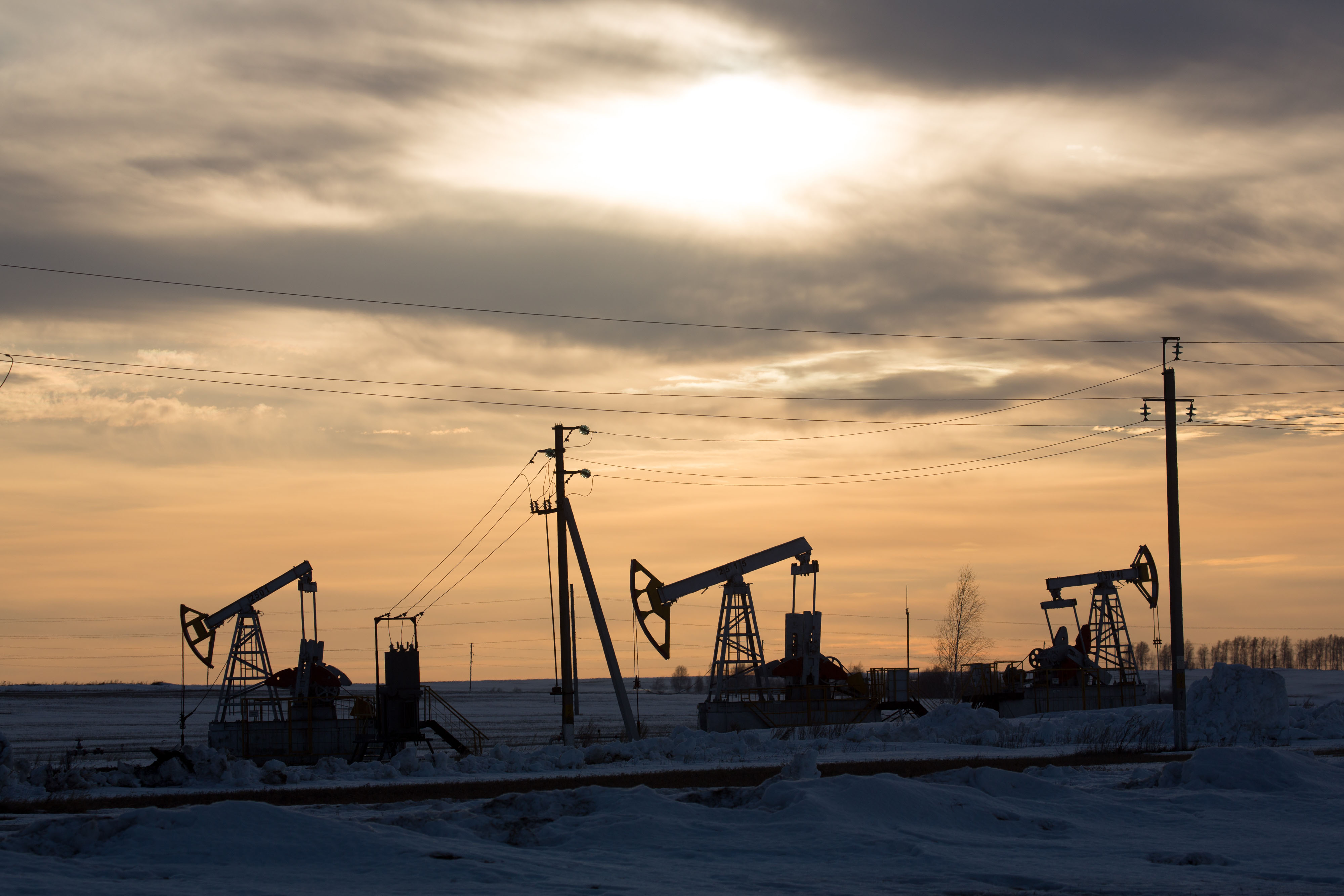Oil price posts two-year highs - but how long can it last?
Brent rose above $59 a barrel this week, its best third-quarter showing since 2004

Oil price falls as Middle East production rises
03 May
Oil prices fell today on the news that production has increased in the Middle East and the North Sea.
Brent crude was at $45.46 at 10.19am UK time, while West Texas Intermediate (WTI) futures were at $44.41. Both had fallen 37 cents from their previous closing price.
The Week
Escape your echo chamber. Get the facts behind the news, plus analysis from multiple perspectives.

Sign up for The Week's Free Newsletters
From our morning news briefing to a weekly Good News Newsletter, get the best of The Week delivered directly to your inbox.
From our morning news briefing to a weekly Good News Newsletter, get the best of The Week delivered directly to your inbox.
A global oversupply of oil has dragged prices lower and lower for most of the last two years. The commodity reached a nadir of $27 a barrel in February but has rallied since.
The news today that more oil is being produced brought prices down, says Reuters. Iraq announced its southern fields averaged 3.364 million barrels per day (bpd) in April, up from 3.286 million in March.
Elsewhere in the Middle East, sources say Saudi Arabia will soon be producing the near-record amount of 10.5 million bpd, after slipping to 10.15 million in March, while Iran is also raising output.
Meanwhile, says Reuters, output from the North Sea will rise 17 per cent in June to its highest in four months, according to industry sources.
A free daily email with the biggest news stories of the day – and the best features from TheWeek.com
Analyst Richard Mallinson, of Energy Aspects, said this increased production would work against recent price increases: "There are enough supply stories out there to slow or temper any gains."
However, he said the dramatic decrease in expensive US shale oil production since oil began to spiral down in value in 2014 will be "supportive to prices in the longer term", says Reuters.
Also looking at the bigger picture, Bloomberg warns the recent recovery "isn't as deep-rooted as it looks at first glance".
The agency says closer examination of trading in five-year-forward WTI suggests buyers believe that, as prices recover, the US will step shale oil production back up - meaning the price recovery will tail off.
Bloomberg quotes oil analyst Michael Wittner, of Societe Generale, who said: "We still believe sustained front-month WTI at $45 to $50 will be self-limiting, as US shale-producer spending and drilling would stabilize and perhaps recover."
Writing for Reuters, John Kemp says the recovered prices are "becoming dangerously overheated" because they are founded on a rebalancing which "has barely started, according to many oil analysts".
This could lead to a "renewed crash when the bubble bursts, as it did after the last big run-up in prices between January and May 2015".
Oil price hits fresh highs for 2016 as Eni posts losses
29 April
The price of oil hit a new high for 2016 today, thanks to a weak dollar and a fall in production of oil in the US, while Italian oil firm Eni announced a larger-than-expected first quarter loss.
Brent crude was up 16 cents at $48.30 a barrel at 9am UK time this morning, while West Texas Intermediate (WTI) futures had risen 24 cents to $46.27 a barrel.
The rise came after a slump in the value of the commodity earlier today. At 3.36am UK time, Reuters was reporting 22-cent and 18-cent falls in Brent and WTI respectively as fears loomed that Opec nations would increase production.
A global oversupply of oil has sent the price of the commodity spiralling down for almost two years, although recent weeks have seen a sustained rebound, so the news that Opec nations might start producing even more dispirited traders.
Deutsche Bank said: "A sustainable rise in OPEC production may be just around the corner, and... the rally may pause.
"Maintenance in the UAE at fields ... is scheduled to end in April, implying a rise from current production of 2.73 million barrels per day (bpd) to the previous 2.91 million bpd production rate in May."
The market rallied, however, and by 9am was touching new highs for the year, helped by the low dollar. The gains were "capped" by the fears of the Opec production rise, Reuters said.
Eni posts losses
Italian oil giant Eni has posted worse-than-expected losses for the first quarter of the year, says the Wall Street Journal. The firm lost €792m (£618m).
In the same quarter of 2015, Eni made a profit of €832m (£649m), says the paper. The firm is suffering as the price of oil plunges and, despite the recovery of the last few weeks, remains pessimistic.
Eni said the market remains weak, with the price of crude oil "exposed to possible negative pressure" caused by uncertainties about demand in the short and medium term.
Oil price eases back as traders 'lock in profits'
28 April
The price of oil has slipped back down again after reaching a 2016 high yesterday. Brent had fallen 27 cents to $46.91 per barrel by 7.38am UK time, while West Texas Intermediate (WTI) was down 20 cents to $45.13 a barrel.
Traders were "locking in profits" after the "sharp rally", says Reuters, and the fall is not expected to continue. With the dollar still dropping and increased appetite from investors, prices could be pushed higher "soon", adds the news agency.
Oil is sold in dollars, so as the greenback declines against other currencies - it has fallen by roughly five per cent so far this year – the commodity becomes a more attractive proposition for non-US investors.
Trader confidence has increased since oil reached a low point in February, after declining in value for almost two years. Optimism has grown following predictions that production will tail off this year, easing the global oversupply.
Those expectations saw oil jump yesterday and Brent crude hit $46.81. It has now risen nearly 20 per cent in April, its largest one-month gain for the past 12 months.
In the US, a weakening dollar also helped WTI to reach new highs for the year, rising 86 cents to $44.90 a barrel.
"We … appear to be at the beginning of a bull market," US investment bank Jefferies said in a note to clients today, predicting that stockpiles of oil will fall by the last three months of the year, "setting the stage for a fundamental recovery".
Nasdaq strikes a more cautious note, saying "concerns of a lingering glut" of oil are weighing down the market.
The latest data from the Energy Information Administration shows that US crude stockpiles grew by two million barrels in the week ending 22 April, instead of declining by 1.1 million barrels as predicted.
While traders are reassured by declining production, they are also eyeing this growing stockpile nervously. Analysts believe they are "wavering" as a result, says Nasdaq, and this will lead to "volatility" in oil prices in the short term.
Oil hits 2016 high as output falls and dollar weakens
27 April
The price of oil has risen to a 2016 high, buoyed up by news of falling output and a weakening dollar.
At 9.35am UK time today, Brent crude futures were up $1.03 at $46.77 a barrel, after earlier hitting a 2016 high of $46.81. In the US, West Texas Intermediate (WTI) crude futures rose 86 cents to $44.90 a barrel.
Brent has now risen nearly 20 per cent in April, its largest one-month gain for the past 12 months.
There were fears two weeks ago that a sustained price rally, after almost two years of decline, would be damaged by the failure of the major producers to agree to limit oil production.
In the event, the predicted major sell-off did not happen. Since then, forecasts made by the International Energy Authority (IEA), BP and others that the global oversupply will rebalance have given investors confidence.
The market was further buoyed when the American Petroleum Institute last night reported that US stockpiles of crude had declined by 1.1 million barrels in the past week. Analysts had expected them to increase by 2.4 million barrels.
Less oil means higher prices, so the news that Saudi Arabia and Kuwait seem to be no closer to restarting production at Khafji, the oilfield they operated together before environmental problems forced its closure in 2014, says Reuters.
The dollar has continued to weaken against other currencies, having dropped by five per cent this year. Oil futures are priced in dollars, so a weaker dollar encourages non-US investors to buy.
Yesterday, the World Bank issued a more optimistic forecast for the average price of oil this year, saying it would be $41 a barrel rather than the $37 it previously predicted - an improvement of some 10 per cent.
But the organisation warned that commodity prices would stay well below last year's levels across the board, hitting resource-rich economies, says the Daily Telegraph.
Oil price dips as BP announces first-quarter losses
26 April
Oil prices dipped today on the news that Saudi Arabia and Iran are racing to bump up production, adding to the global oversupply.
Brent crude had fallen 11 cents to $44.37 per barrel by 7.39am UK time, while US crude futures were down 12 cents at $42.52. The dip came after an early rally, boosted by a weak dollar and new investment.
Regional political rivals Saudi Arabia and Iran seem to be ramping up output in a race for customers, after sanctions were lifted on Iran, says Reuters.
That's bad news for many investors: more oil being produced will mean lower prices. For two years, the price of oil has been in freefall as global supply outstrips demand.
"The biggest bear risk to the oil market right now is that Iran's ramp-up accelerates and then that Saudi Arabia does the same," said Citi in a note.
BMI Research has upgraded its forecast for Saudi crude production, "reflecting the failure of the meeting at Doha, planned increases in output capacity and the creeping politicization of oil under Deputy Crown Prince Mohammad bin Salman".
BP announces losses
Meanwhile, BP has announced lower-than-expected losses for the first quarter of 2016 after its refining and trading operations compensated for the damage it suffered from the low oil price in its production and exploration divisions.
While BP lost $485m (£333m) for the three months to March on the "replacement cost" measure, its profits rebounded on an underlying basis, says the Financial Times.
This measure of profit/loss is closely watched by analysts - and they had expected BP to announce a $140m loss. Instead, the firm posted $532m profit, when one-off costs are stripped out.
The news boosted the company's share price, which opened up 2.6 per cent to 370p on Tuesday morning.
Compared to its position 12 months ago, however, BP is doing badly on any measure. It recorded an adjusted profit of $2.58bn for the first quarter of 2015, more than $2bn more than this year.
Brent crude averaged $34 a barrel in the first quarter of this year, compared with $44 in the last three months of 2015 - and $54 in the first quarter of 2015, the BBC notes.
BP chief executive Bob Dudley remained bullish, however, saying he expects the global oil market to rebalance by the end of this year, bringing higher prices for oil.
-
 How drones have detected a deadly threat to Arctic whales
How drones have detected a deadly threat to Arctic whalesUnder the radar Monitoring the sea in the air
-
 A running list of the US government figures Donald Trump has pardoned
A running list of the US government figures Donald Trump has pardonedin depth Clearing the slate for his favorite elected officials
-
 Ski town strikers fight rising cost of living
Ski town strikers fight rising cost of livingThe Explainer Telluride is the latest ski resort experiencing an instructor strike
-
 How might the Israel-Hamas war affect the global economy?
How might the Israel-Hamas war affect the global economy?Today's Big Question Regional escalation could send oil prices and inflation sky-high, sparking a worldwide recession
-
 Recent mega-mergers could signal a turning point for the US oil industry
Recent mega-mergers could signal a turning point for the US oil industryTalking Point Both Chevron and Exxon have recently spent billions to acquire smaller oil companies
-
 Has Saudi Arabia lost control of oil prices?
Has Saudi Arabia lost control of oil prices?Today's Big Question Kingdom goes it alone to cut production, risking tension with US and reigniting cooling inflation in Europe
-
 US angered by Opec+ oil cut
US angered by Opec+ oil cutSpeed Read Energy prices to rise further as producers slash supply by two million barrels a day
-
 Global oil demand forecast lowered for 2020 and 2021
Global oil demand forecast lowered for 2020 and 2021Speed Read IEA report says jet fuel demand remains the major source of weakness
-
 Are US-Iran tensions flaring again?
Are US-Iran tensions flaring again?In Depth Trump threatens military action over Twitter
-
 Can a deal be struck to raise oil prices?
Can a deal be struck to raise oil prices?In Depth Opec+ will convene today over video link in a bid to boost crude
-
 What do negative oil prices mean?
What do negative oil prices mean?In Depth Perfect storm of oversupply and storage shortages sees producers paying to get rid of US crude